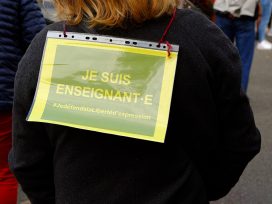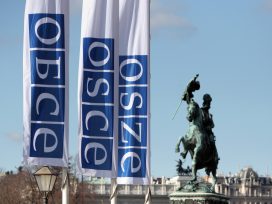Goodbye, Isis
‘Practically every home in Pankisi bears the scars of the Second Chechen War, the Abkhazian War and the Syrian War. Practically every home has ties to the Islamic State.’ In this excerpt from her book ‘Goodbye, Isis: What Remains is Future’, Kateryna Sergatskova travels to the birthplace of Tarkhan Batirashvili, aka Omar al-Shishani, the former IS ‘Minister of War’.
I was just a child when a group of Chechens attacked the train taking my mother and me to Sochi. It was night or late evening, and a heavy cobblestone crashed into our compartment window. The stone flew past me and fell somewhere in the passage. All I remember was how my mother shielded me with her own body. We slowly slid down to the floor together and crawled into the next compartment, trying not to cut ourselves on the shards of broken glass. I still recall a vast round hole in the window.
It was scary, but I don’t remember what was more frightening, that the women around me were shaking and praying out loud in a fit of panic or that someone said the Chechens were threatening the conductor with a knife. I remember muffled screams from the connecting passageway with the next train car; a fellow passenger had gone to help and gotten stabbed in the face. It all ended quickly, and the train continued onward. More than twenty years have passed since that day, but I still don’t know why it happened. Why did they attack the train? Did they get what they wanted?
A few years later, I started working as a journalist, and ethnic conflicts became one of my main topics. I lived in Russia, where the level of xenophobia, the fear of any manifestation of otherness, was very high, especially in my native Volgograd, which is several hundred kilometers from Chechnya and where many Chechen families fled from the war. My articles about Russian nationalists’ attacks on people from the Caucuses aroused unhealthy interest among the conservative public. Unfortunately, little has changed since then.
The breakout of the war in Syria in the early 2010s was an incredible shock to the world. This conflict was not entirely local: in 2012, hundreds of citizens from all over the post-Soviet space rushed there. Among them were many Chechens, Dagestanis, Georgians, Uzbeks, Kazakhs, Tajiks, and Tatars, whose primary motivation was to escape from the authoritarian states in which they lived. The war in the Middle East promised them money, new experiences, and freedom. Many of them became the backbone and military wing of the bloodiest terrorist organization of our time, the Islamic State. Without their participation, Syria and Iraq would not have lost thousands of citizens in the war. More than six million refugees would not have had to look for a new home and suffer from misunderstandings in a foreign land.
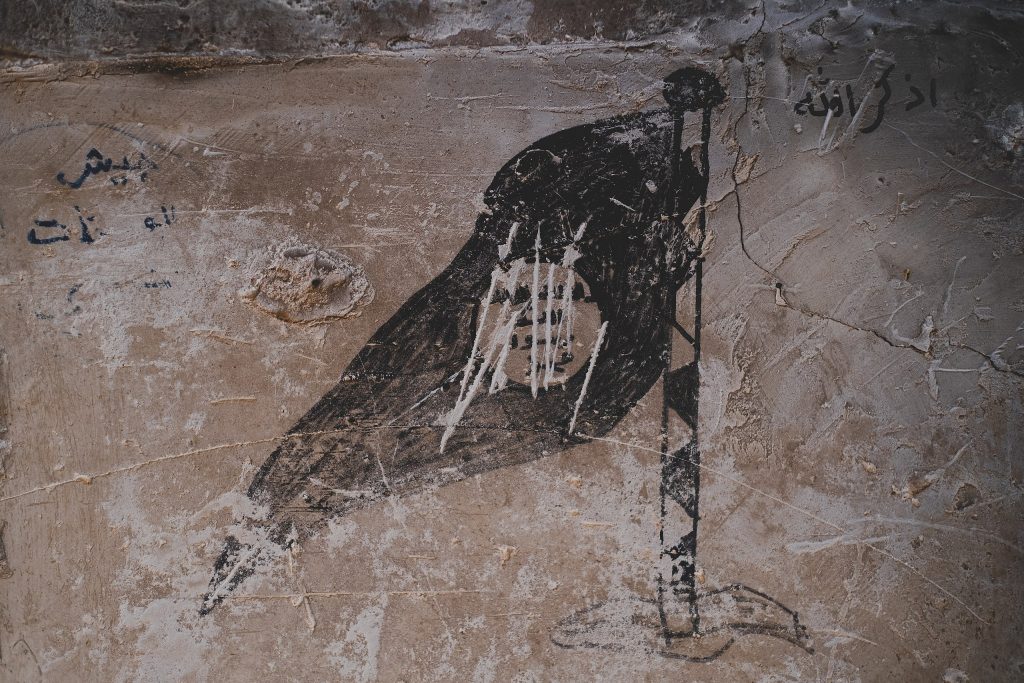
Image: Levi Clancy / Source: Wikimedia Commons
One day in the summer of 2016, I met one of the main characters featured in this book, a former Islamic State militant. I went to our first meeting in a state of horror: God, I’m going to meet with a terrorist! But he seemed to be as frightened as I was. We began to communicate regularly through various online messengers, and in three years, he told me enough for me to gain a full picture of the relationship between fighters and groups within the Islamic State and reconstruct the course of events in Syria and Iraq at the scale of human growth. This was what I’d lacked from the cold news coverage of the Middle East front. If not for him, we would not have known the path the teenagers brought up in Soviet families embarked on when they decided to fight on foreign territory.
Over the course of five years, I managed to get to know other ISIS fighters, including Chechens who fought in Syria and then in Ukraine, as well as the remnants of the ISIS underground in Georgia, and the wives of militants who ended up in prisons and refugee camps… All this helped me to understand how small the world of terrorism is. When I began to collect all these stories into a book, they were incredibly interconnected.
Several years have passed since the defeat of the so-called Islamic State, but thousands of people who participated in the war on the side of the most brutal terrorist organization continue to live beside us. They are inexorably present in our common space. And at the same time, the edge is not far from us. Participation in the war on the side of the terrorists left an indelible mark on their lives; they were expelled from society. After everything that happened, they will never again be able to live as before. All they have now is to hold on to a future where they can imagine themselves freed from the burden of their past. However, this future is unlikely ever to come.
I am grateful to all those who opened up to me and shared stories that no one had heard before. These testimonies have proven crucial in unraveling the complexities of our delicate world and, in turn, shaping our collective path forward.
…
Boss of hell
It’s nighttime in the Pankisi Gorge. The ‘official representative’ of the Islamic State in Georgia settles into a wicker chair opposite me. We find ourselves in a guesthouse in the village of Jokolo.
My interlocutor is a slightly dishevelled, middle-aged Kistin with a carefree demeanour. His name is Jakolo, just like the village, but spelled with a difference of one letter. He is a relative of Leyla, who runs this guesthouse. In the Pankisi Gorge, it’s said that every second person is related to one another.
Pankisi is a picturesque rift in the northeastern part of Georgia, formed by the breakage of mountains on either side of the Alazani River. Mountains come in various forms: rolling, flat, jagged, undulating, rocky, bald, with gullies… But here, the mountains twist into spirals and sharpen upwards. They protrude like devil’s horns from beneath the ground.
These horns border Dagestan and Chechnya.
Several villages are scattered throughout the gorge, with approximately 10,000 Kists residing here. Exact figures are unknown. Kists are ethnic Chechens who resettled in Georgia four hundred years ago.
If there are places destined to be cursed, then Pankisi is such a place. Cursed places always arise at fractures, at the crossings between worlds, cultures, languages, laws. In such places, where one’s own and the foreign intersect, boundaries blur: everyone becomes a stranger to each other. And everyone becomes a bit of themselves.
There is only one café in the entire gorge. It is located at the entrance to the largest of the four villages, Duisi, and you’re unlikely to realize it’s a café unless you’re informed in advance. It’s situated inside a small metal carriage – usually home to construction workers. In the Duisi café, they serve nothing but khinkali. Three smiling women work in the kitchen, each with her head covered by a scarf. They offer guests homemade non-alcoholic beer – a rosehip concoction tasting like kvass or sweet soda. The café opened a few years ago with funds from American taxpayers – the USAID foundation, which finances democracy development projects in unstable countries.
American taxpayers also funded the most popular guesthouse in the village of Jokolo. It was built by Leyla Achishvili to host guests from Poland, Ukraine, Japan, and from wherever else fate takes them. USAID supported her business shortly after she returned from Syria, from the territory of the Islamic State.
Practically every home in Pankisi bears the scars of the Second Chechen War, the Abkhazian War, and the Syrian War. Practically every home has ties to the Islamic State. Pankisi is among those places where heaven meets hell.
Jakolo calls himself the official representative of the Islamic State. He has never been to Syria or Iraq, and travel to Turkey is prohibited for him by the Georgian authorities. Nevertheless, he considers himself an authorized representative of the most ruthless terrorist organization in the world. Before him, the imam of the Salafi mosque in the village of Jokolo and his close friend Ayub Borchashvili held this position. In 2015, Ayub was arrested for recruiting underage Georgian Chechens into the ranks of the Islamic State and was sentenced to fourteen years in prison.
Additionally, Jakolo was a close friend of Tarkhan Batirashvili, the defense minister of the Islamic State, otherwise known as Abu Omar al-Shishani. Jakolo adored him.
‘Here, guess who this is?’ Jakolo thrusts a smartphone with a photo under my nose. In the picture, two young men in khaki coats are sitting arm in arm on a bench, laughing. To the left of the person vaguely resembling Jakolo is a freckled guy with a shaven head and a smoothly shaved face.
‘That’s Omar,’ Jakolo says hoarsely.
Tarkhan Batirashvili was born in 1986 in the small village of Birkiani. Deep in the Pankisi Gorge, in a family of an Orthodox Georgian and a Kist Muslim. Such unions were only possible in the Soviet Union, where religion was considered a very personal and therefore secret matter. After all, the Soviet person was devoid of churches – people were raised as atheists who had to believe only in communism, space exploration and Soviet engineering. At that time, neither religion nor ethnicity was a matter of pride or public discussion but served as self-identification in a complex region.
Tarkhan was born at a borderline time in a borderline place. The Second Chechen War unfolded before the eyes of the red-haired teenager. He learned about the struggle for independence through refugees from the North Caucasus in the breaks between work. He herded cattle in the mountains – many children in the gorge worked as shepherds back then. After finishing school, when it was time to decide what to do next, Batirashvili didn’t deliberate much: he joined the army in 2006.
The Ministry of Defence of Georgia was already being financed by the US government at that time, and the military were undergoing training with the American special forces. In August 2008, the Russian army invaded the territory of Georgian Ossetia and Abkhazia with a special operation, which Russian President Dmitry Medvedev called ‘coercion to peace’, and Tarkhan became a soldier in his first real war. And he suffered his first major setback: he contracted tuberculosis. He was discharged from the army, and he was forced to return to the unemployed gorge.
One of the former high-ranking officials of the law enforcement system of Georgia, L. (I haven’t not disclosed his name at his request), said that Batirashvili was one of the agents recruited by the special services. He worked for the Ministry of Internal Affairs and the Antiterrorist Centre created under it. The security forces noticed him, said L., thanks to his older brother Tamaz. He fought in Chechnya during the second campaign and was an authority figure for the Kists. According to L., among his friends were influential field commanders, ‘real wolves’.
The task of the younger one, Tarkhan, included the duty to report everything that happened in the Chechen community in Pankisi. The young Kistin so wanted to work in the security forces that he did everything he was asked to do. In addition to working for the special services, Tarkhan moonlighted as a fixer for militants who were not familiar with the local situation in the gorge. He helped them find people who wanted to buy or sell weapons and drugs. He was a kind of messenger.
Once, L. recounts, Tarkhan’s brother, Tamaz, provided intelligence with data on a group of soldiers who entered Georgia with a large batch of weapons. The military didn’t like it. Soon Tarkhan, along with several militants, was arrested for possession of ammunition. L. said that the ammunition was planted on Tarkhan. The future commander of the Islamic State ended up in prison for two years. ‘He wanted to serve Georgia, but they just kicked him out!’ laments Jakolo.
Nighttime in Pankisi. The face of the official representative of the Islamic State is illuminated by the ember at the tip of a strong Marlboro cigarette. He becomes nervous remembering his friend.
In prison, Tarkhan befriended Georgians and Chechens who fought alongside militants in the North Caucasus, and it was there that he converted to Islam. It was behind bars that he decided to join the global jihadist movement. In 2012, he was released early as part of an amnesty and went to Turkey. From there, he crossed the border and found himself in Syria, where a civil war was already raging. Tarkhan adopted the pseudonym Omar al-Shishani, meaning Omar the Chechen, and joined the Caucasian group Jaish al-Muhajireen wal-Ansar, the ‘Army of Emigrants and Helpers,’ later pledging allegiance to the Islamic State. Omar al-Shishani became one of the most influential commanders among terrorists in the Middle East. He was even dubbed the Minister of War.
‘And here he is in Syria,’ says Jakolo, handing over his phone. The picture shows Tarkhan Batirashvili standing next to a snow-covered fir tree, somewhere in northern Syria, a landscape similar to those found in Latakia, near the Turkish border. In this photo, the Kist man has grown a long red beard and wears a turban on his head.
It’s nighttime in Pankisi, but Leyla isn’t sleeping. Occasionally, she peeks out of her room to check if the terrace has been freed. The name Omar al-Shishani holds a special significance in her home.
Everything started earlier
When Leyla’s eldest son, Hamzat, turned seventeen, she sent him along with his younger brother, Khalid, to study with their father in Austria, so they wouldn’t languish among the radical youth in Pankisi. Ten years later, she says, Hamzat returned home with a good education, fluent in five languages. But in 2013, he abruptly left for war in Syria. There, he became the translator and close friend of Tarkhan Batirashvili.
In Syria, Hamzat married one of Chechnya’s most sought-after brides, Seda Dudurkaeva, the daughter of Asu Asu Dudurkayev, who was then the head of the migration service in Ramzan Kadyrov’s government. When she fled to Syria to be with Hamzat, Kadyrov disgracefully dismissed the official and ordered Seda to be found and returned home. Leyla travelled to Syria to understand what her son was doing with weapons in a foreign country. When she finally reached him, she saw a completely different young man – he was ready to die for the Islamic State and believed it would help achieve justice for Muslims. Hamzat travelled in Omar al-Shishani’s armoured jeep, camouflaged and laden with weapons. The militants greatly respected him, especially for managing to win over the beauty Seda despite Kadyrov.
Seda was Leyla’s second concern – she was called by the administration of Chechnya and asked to persuade Dudurkaeva to return home. But neither her son nor his wife wanted to do so.
When Leyla returned to the Pankisi Gorge from her exhausting journey, she was contacted by Hamzat’s friends. They reported that he had died in one of the battles for the Islamic State. When her younger son, Khalid, learned of this, he told his mother that he wanted to ‘become a martyr’ just like his brother. Several months later, Leyla’s younger son also died in Syria.
Seda remained a widow for a short time. After Hamzat’s death, Omar al-Shishani took her as his wife. According to Muslim custom prevalent in radical circles, the widow of a martyr should come under the protection of the elder. Over time, the Chechen woman bore two children to Tarkhan Batirashvili.
In July 2016, the ‘Minister of War’ was killed. American aircraft struck the building where he was hiding with his unit.
Seda contacted Leyla and asked for help to escape from Syria. However, she was prevented by Tarkhan’s older brother, Tamaz. On July 4, 2018, Dudurkaeva was arrested in Turkey with fake documents and her two young sons in her arms – she had managed to escape from Raqqa in Syria to Idlib, and from there, across the border, to the Turks. Two weeks after her arrest, it became known that Batirashvili’s brother was dead.
‘It’s a shame he’s gone,’ Jakolo says. ‘Omar was a very good friend.’
Jakolo lights another cigarette. He admits to me that he has long wanted to leave Georgia, but the Georgian authorities won’t allow it. They don’t want an ‘official representative’ of the Islamic State to appear in Europe with a Georgian passport. But they don’t imprison him, either – he willingly shares information about everything happening in the underground scene. It benefits the intelligence services to keep such a person close and free.
‘It’s lousy here,’ says Jakolo, extinguishing his cigarette in the overflowing ashtray. Leyla kindly takes the ashtray and empties it into a bucket. Then Jakolo bids us farewell and quickly disappears into the night landscape.
Chechnya without Chechens
An elderly man in a light straw hat unlocks the door to the only room of the Pankisi Gorge’s Ethnography Museum. This man is Khaso Hangoshvili, a respected elder and member of the Kist community residing in the gorge.
Beneath the straw hat, Hangoshvili’s reddish-grey hair is visible. Khaso painstakingly crafted the Pankisi Ethnography Museum himself, aiming to educate the few tourists who ventured to this area – drawn by horseback riding along picturesque mountain trails – about the rich cultural heritage of the region.
At the entrance to the museum hangs a plaque with photographs of Chechens with Kalashnikov rifles somewhere in the mountains, smiling broadly, posing happily for the camera. Next to them is a portrait of Imam Shamil. Shamil, a Dagestani, was a legend of the liberation war of the North Caucasus against the Russian Empire in the 19th century. He united Dagestanis and Chechens into one Imamate format of rule, akin to an emirate. Imam Shamil spent his last years in Kyiv. There is a plaque in his honour near Independence Square. Contemporary peoples of the North Caucasus revere Imam Shamil as a hero of Muslim anti-colonial struggle.
‘War is the national specialty of the Vainakhs,’ says Hangoshvili. Over sixty, he moves with the aid of crutches, and drives a jeep. The straw hat creates an image of Clint Eastwood’s character from the spaghetti western The Good, the Bad and the Ugly. Even Hangoshvili’s eyes are the same transparent shade of blue, and his hair is as straw-like as in the movies.
The duties of the elder include resolving disputes between local residents and communicating with Georgian authorities in case of conflict in the gorge. The museum is just his hobby. There are not many exhibits in the single museum room. His favourite, says Khaso, are the bronze clocks, shaped like the building of the government of Ichkeria in Grozny. The twelve-story building, which housed the Republican Committee of the Communist Party before the Chechen revolution, was bombed during the First Chechen War. There, on the eighth floor, was the public reception of President Dzhokhar Dudaev of Ichkeria. Hangoshvili proudly recalls visiting there in the mid-nineties, when Dudaev was still alive.
On the wall at the entrance to the museum, Hangoshvili hung a poster with the slogan: ‘Their god is freedom. Their law is war.’
‘You see,’ continues the elder, ‘the Vainakhs haven’t had forty years without war to rebuild the economy, create culture, and start peace. They don’t know peace, that’s the problem.’ The Chechens have a long history of resistance against the Russian Empire.
In the 18th century, the Vainakhs, along with the Tatars, resisted the armies of Catherine II under the command of Prince Potemkin. During a prolonged war, the Caucasus was forcibly annexed to the Russian Empire. In the 19th century, resistance was led by Imam Shamil. In the 20th century, the Bolsheviks arrived in the North Caucasus and, like the imperial forces before them, attempted to colonize the mountainous region.
Vainakh society has never been accustomed to submitting to colonizers. The lives of Chechens, Ingush, Avars and other peoples of the Caucasus have always been structured around clan hierarchy, family loyalty and adherence to the customs of Muslim society. Caucasians have been accustomed to working their own land and being masters in their own homes. However, the Soviets came with the idea of collectivization and industrialization, equalizing everyone under the authority of Moscow. In 1931, during a period marked by Joseph Stalin’s directives to exterminate affluent peasants across regions seized by the Bolsheviks, and the orchestrated famine in Ukraine known as the Holodomor, over 35,000 Chechens were arrested and executed. Among them were religious leaders, kulaks, and nationalists. Thousands died from hunger and disease.
During World War II, Chechens died on the front lines but did not want to remain under Soviet rule. On 23 February 1944, on a day now celebrated in Russia as Defender of the Fatherland Day, 450,000 Chechens and Ingush were loaded into freight trains and deported from Russia to the outskirts of the new Soviet empire, to the steppes of Turkistan. The operation was called ‘Operation Lentil’: they were sent to Kazakhstan as collaborators, although Chechens had never been under German occupation. The Vainakhs were expelled from their homeland because they refused to submit to Soviet rule. A quarter of them perished during the first four years of forced exile. They were only able to return home after Stalin’s death, from 1957 onwards.
Dzhokhar Dudaev was eight days-old when his family, along with other Caucasians, was deported to Kazakhstan. His parents died during the deportation. He returned to his homeland as a teenager and learned about the reasons for the deportation from his older brothers. Dudaev grew up as a Soviet man, but the memory of how the Soviet authorities treated his people lived within him like a parallel life.
By the 1980s, he had risen to the rank of major general in the Soviet Air Force and commanded bomber divisions first in Poltava, Ukraine, then in Tartu, Estonia. It was in Tartu where he took the first step towards the abyss in the early 1990s, when anti-Soviet sentiments swept across the Soviet Union. He helped Estonia break free from occupation. As the garrison commander of Tartu, Dudaev refused to follow Soviet orders to block Estonian television and parliament. Soon after, he returned to his native Chechnya and proclaimed the independence of Ichkeria from Russia and the USSR. However, for President Boris Yeltsin, giving up Chechnya meant allowing Russia to fall apart, as independence would also be demanded by Dagestan, Ingushetia, Bashkortostan and other national republics.
The war had begun.
In the First Chechen War, thousands of participants of the Chechen resistance and civilians were killed. In the first two years, 15,000 Russian soldiers died.
‘They say we are friends with Russia, although we are very fierce enemies,’ said Dzhokhar Dudaev. In 1996, he was killed, and a new stage began in the history of Chechnya. The war ended briefly. After the conditional and short-lived victory of the separatists, Chechnya plunged into post-war darkness. Violence, poverty, and fear flourished in the republic.
After Dudaev’s death in 1996, Shamil Basayev called for the withdrawal of all Muslim republics of the North Caucasus from Russia and their unification into a single state living according to Sharia law. Later, he was dubbed the new bin Laden for his radicalism. He spoke of using weapons of mass destruction against Russia and achieving the creation of a caliphate from the Caspian to the Black Seas.
At the end of 1999, on the night before New Year’s Eve, Yeltsin announced his successor, former FSB director Vladimir Putin. The first thing Putin did as president of Russia was to go to Chechnya to support Russian soldiers. He called the second Chechen military campaign ‘liberation’ so that Chechens would not feel defeated. Russian soldiers were allegedly there not to force Chechens to surrender their weapons and give up the idea of the republic’s independence but to liberate them from terrorist rule. Even such a version was heard in the official press: Chechen terrorists started a war with Russia to carry out genocide against Chechens with the hands of Russian soldiers. At that time, such ideas seemed wild to many, but the term ‘liberation’ for justifying colonial policies caught on and continued to be used to later justify the occupation of territories in Georgia and Ukraine and military intervention in Syria.
In the photographs of the early 2000s, Grozny, the capital of Chechnya, looked like Stalingrad in post-war shots. Military vehicles moved through streets where there were no houses – they had turned into burnt skeletons of buildings. Death reigned where people had once lived.
Hundreds of thousands of soldiers from all over Russia arrived daily to fight for the ‘liberation’ of Chechnya. At the entrance to Chechnya, a sign on the fence flaunted: ‘Freedom or death. Chechnya is a subject of Allah.’
Many Russians did not understand what they were fighting for. Army propaganda portrayed Chechens as non-human. Animals. Wolves that needed to be tamed, taught a lesson. Filtration camps appeared and soon became the scariest places in Chechnya. Chechen men aged 14 to 60 were taken to the camps and beaten, sometimes to death. Girls and women were raped there. Journalists and human rights activists devoted many publications to these camps. Those who managed to survive told how soldiers knocked out detainees’ teeth and laughed that ‘the wolf is now toothless’. Some were subjected to a ‘living corridor’: soldiers lined up on both sides of the chamber armed with rifles and iron rods, and the detainee had to run through the ‘corridor’ to the end. Those who fell halfway were beaten to death. Chechen militants also tortured Russian soldiers – they tortured, killed, and mutilated dead bodies. Evil went unpunished; it was rewarded.
Violence in Chechnya was everywhere. Later, many Russians who had experienced Chechnya left to ‘liberate’ Ukraine from the fictitious fascists portrayed by Russian propaganda. For example, Igor ‘Bes’ Bezler and Igor ‘Strelkov’ Girkin fought against the Chechen resistance and then participated in the seizure of the Donbas region. Many of them were involved in creating prisons for Ukrainian military personnel and civilians who publicly disagreed with the occupation. Those who managed to escape told of brutal torture conducted by Russian officers.
And yet…
Today, above the railway tunnel in the centre of Grozny, there gleams a wide memorial plaque with a statement by Akhmat Kadyrov: ‘Let justice prevail.’
Kadyrov became the head of the Chechen Republic in the summer of 2000, six months after Vladimir Putin took office as President of Russia. Previously, Kadyrov had been the mufti of Ichkeria since 1995 and had sided with Chechen resistance. Moscow offered him a deal: peace in exchange for loyalty. At that time, almost every Chechen had lost at least one relative in the war, every other person had been bombed, or had witnessed someone’s death. Continuing the war was unbearable. Many agreed to give peace a chance, although they remembered Dudayev’s words: ‘Better to die than to be unfree.’ Some militants emerged from the underground and joined Kadyrov’s new army, while those Chechens who decided to continue the fight for independence went deeper into the forests and began to develop radical ideas of resistance, including planning kidnappings, sabotage, and terrorist attacks.
‘A Chechen cannot be fearful, cannot be a coward,’ says Khaso Hangoshvili. He looks at the cast iron clock in the shape of the Ichkeria government building. There are no hands on the clock. The buildings on the map of modern Grozny are long gone – they were destroyed during the Second Chechen War.
‘If someone in the family is noticed to be growing up cowardly, they make them…’ the elder falls silent to regain composure, ‘they make it so that he fears nothing. When I was little, there were ancient cult buildings in our mountains. The elders deliberately told us that there were devils, demons in the mountains, who could destroy… And they gave us a task: ‘Go,’ they say, ‘at night, put your hat there.’ I went, I put it on. Then they tell another: ‘And you go and bring that hat back.’ They spoke so that we would be scared, but we went.’
‘But why?’ I ask the elder.
‘Because for the Vainakhs, it’s better to die than to be afraid,’ says Khaso and demonstratively adjusted his straw hat.
Translated from the Russian by Kate Tsurkan Ukrainian publisher: Samit-knyha, Kyiv, 2021
Published 21 March 2024
Original in Russian
Translated by
Kate Tsurkan
First published by Eurozine (English version)
© Kateryna Sergatskova
PDF/PRINTIn collaboration with
Newsletter
Subscribe to know what’s worth thinking about.
Related Articles
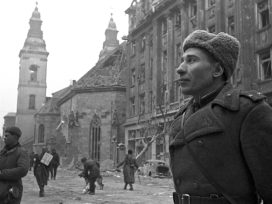
Two opposing interpretations of 1945 form the ideological core of today’s confrontation between Russia and the states of central and eastern Europe. Both are reactions to the collapse of the Cold War order.
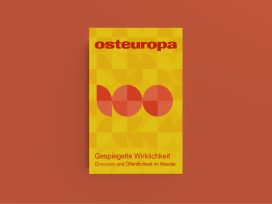
In the spirit of the times and against the grain
Osteuropa 1–3/2025
Osteuropa at 100: Manfred Sapper on the history of the journal from Weimar to the present; Gerd Koenen on a century of German–Russian projections; Katharina Raabe on eastern European literature in translation; Dorothea Redepenning on the bilateral politics of classical.



